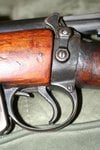Airframes
Benevolens Magister
Sure did! Can't see properly, but it appears to possibly have the magazine cut-off, a fairly rare thing to find these days, although that didn't really start to appear until about the second year of WW1 on the SMLE.
Follow along with the video below to see how to install our site as a web app on your home screen.
Note: This feature may not be available in some browsers.
Ad: This forum contains affiliate links to products on Amazon and eBay. More information in Terms and rules


















I doubt that anybody would mount a scope on wood, or even if those brass screws went through to the barrel underneath, it still wouldn't a good idea to mount the scope with wood under it. The wood slightly contracting and expanding from changing moisture content would move the scope around.
I do wonder what they are for .